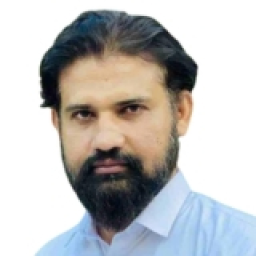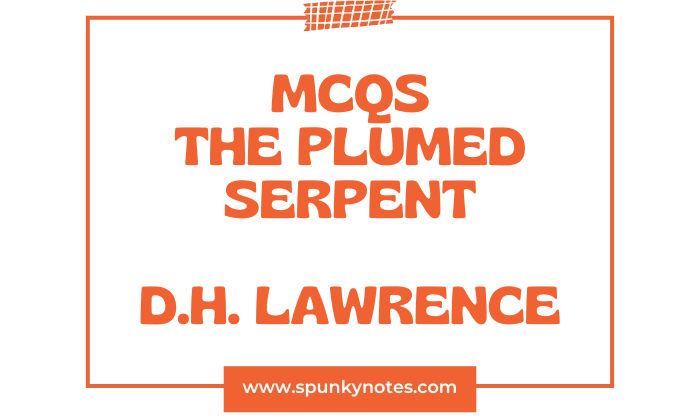

Updated on: October 21, 2025
Estimated Reading Time: 19 min

Estimated Reading Time: 19 min
The Plumed Serpent MCQs
1. What city hosted the last bull-fight of the season?
A. Guadalajara
B. Mexico City
C. Vera Cruz
D. Tlacolula
2. What materials were used to construct the huge, ugly stadium?
A. Wood and glass
B. Iron scaffolding, concrete, and iron
C. Adobe and stone
D. Concrete and marble
3. Kate said she hated “common people” after witnessing which activity?
A. Selling greasy food
B. The common rowdiness of the audience
C. The military entrance
D. The general rush
4. What did the toreadors look like to Kate, shattering her illusions?
A. Gallant heroes
B. Eunuchs or women in tight pants
C. Expert horsemen
D. Elegant gentlemen
5. What horrific sight shocked Kate during the bull-fight?
A. The bull dying instantly
B. The toreadors’ cruelty
C. A horse walking out with entrails hanging out
D. The crowd rioting
6. Why did Kate leave the bull-fight early?
A. She was bored and overwhelmed by the indecency
B. She was afraid of the military
C. She needed to meet General Viedma
D. Owen was feeling sick
7. Which character approached Kate to offer her transportation away from the stadium?
A. Villiers
B. General Viedma (Don Cipriano)
C. Owen Rhys
D. Julio Toussaint
8. What nationality did Kate claim to General Viedma?
A. American
B. English
C. Irish
D. Scottish
9. What did Kate feel about General Viedma that made her want to get away from him?
A. His insolence
B. His heavy, black Mexican fatality
C. His overwhelming kindness
D. His aggressive Americanism
10. What philosophical despair did Owen suffer from?
A. Despair of not having enough money
B. Despair of having lived in vain
C. Despair of being stuck in Mexico
D. Despair of being too old
11. What feeling overcame the people discussing Mexico seriously at Mrs Norris’s house?
A. Patriotic pride
B. Intense irritation
C. Doom and despair
D. Will-to-happiness
12. Don Ramón said Mexicans truly mean this when they cry “Viva!”
A. Long live liberty!
B. Long live Montes!
C. Death for Somebody or Other!
D. Long live Christ the King!
13. What was Don Ramón’s voice compared to?
A. A drum
B. Metal music
C. A violoncello
D. A parrot
14. What did Kate call the heavy, black Mexican fatality she felt in Mexico City?
A. The dragon of the Aztecs
B. The altitude sickness
C. The weight of revolution
D. The curse of the tropics
15. What does Quetzalcoatl literally mean?
A. Fire serpent
B. Feathered man
C. Plumed Serpent
D. Golden eagle
16. What did Kate’s second husband, Joachim Leslie, fight for?
A. Irish politics (changing the world)
B. Socialism in Mexico
C. American ideals
D. Academic scholarship
17. According to Don Ramón, what is nonexistent, as men are slaves to domination?
A. Will-to-happiness
B. The search for God
C. Liberty
D. Socialism
18. What did Ramón say he needed to make the world’s roots rise again?
A. Land reform
B. The word
C. Violence
D. Foreign aid
19. Cipriano’s education was described as lying upon his consciousness like what substance?
A. A thick black shroud
B. A film of white oil on a black lake
C. A shining jewel
D. An iron mask
20. What did the naked man in the river claim the lake belonged to?
A. The government
B. The old gods of Mexico
C. Don Ramón
D. The fishermen
21. What was the Quetzalcoatl emblem on the leaflet?
A. Eagle with serpent eating its tail
B. Plumed serpent head
C. Crucifix
D. Morning Star
22. The singer of the Quetzalcoatl hymn sang inwardly, into which dimension?
A. The future
B. The infinite room inside the axis of wheeling space
C. The spirit of God
D. The depths of the earth
23. What action did the women perform to choose their man after the speech?
A. They danced in a circle
B. They slipped in and picked up the man’s right hand
C. They threw flowers at them
D. They sang a private song
24. What was the Snake of the earth said to be doing at the heart of the earth?
A. Sleeping in the midst of fire
B. Coiling round the globe
C. Waiting for victims
D. Moving the tectonic plates
25. In the Hymn, what did Jesus say the Mexican people had swallowed, making them heavy?
A. The stone of despair
B. The fire-waters
C. The silver cross
D. The foreign tongue
26. What was the fate of the images (Dead Christ, Madonna, etc.) from the church?
A. They were stolen by bandits
B. They were hidden in the hacienda
C. They were reverence-burnt upon the lake
D. They were sent back to Rome
27. What celestial object was said to set the dragons upon the inert ones in the Fourth Hymn?
A. The Morning Star
B. The Sun
C. The Moon
D. The North Star
28. Who was Carlota’s godfather of her younger son?
A. Owen Rhys
B. General Viedma (Cipriano)
C. Judge Burlap
D. Montes
29. What sound made Doña Carlota rock herself in agitation at Jamiltepec?
A. The military bugle
B. The thunder
C. The church bells
D. The drum
30. What curse did Kate feel she suffered from, leading to her “spasmodic desire”?
A. The curse of Eve/greedy vision/prying eyes
B. The curse of the tropics
C. The curse of being Irish
D. The curse of pride
31. What did Ramón say was the ‘Morning Star,’ rising between man and woman?
A. Their shared destiny
B. Their combined soul/meeting-ground
C. Their desire for peace
D. Their children
32. What was the visible effect of Carlota’s final collapse in the church?
A. Carlota was shot by a soldier
B. Carlota went into convulsions and collapsed
C. Carlota successfully disrupted the event
D. Carlota spoke in tongues
33. What did Ramón say was ‘Good’ about the bandits he and Kate killed?
A. Good that they ran away
B. Good that they are dead
C. Good for Mexico’s future
D. Good for Carlota
34. What animal did Ramón compare the job of transforming Mexico to?
A. Hatching the chick
B. Killing the snake
C. Climbing the mountain
D. Hunting the jaguar
35. What was the core reason Ramón was going to marry Teresa?
A. To secure her dowry
B. He was madly in love
C. To save her sex/pride from insult
D. To anger Carlota
36. What did Kate feel was lacking in Cipriano, leading to her fear and repulsion of his mystical power?
A. Kindness
B. Military skill
C. English culture
D. Loyalty to Ramón
37. What name did Cipriano use for Kate after she submitted to his power?
A. Itzpapalotl
B. Teresa
C. Malintzi
D. Caterina
38. What was the name of the strong-scented flower Cipriano used to decorate Kate’s chair in the church?
A. Oleander
B. Buena de noche (good by night)
C. Hibiscus
D. Jasmine
39. What new god name did Cipriano claim for himself?
A. Tezcatlipocá
B. Huitzilopochtli
C. Tlaloc
D. Montes
40. What did Kate say was her primary desire when she felt suffocated by the new Mexican movement?
A. To return to the simple life in London
B. To join the military
C. To become a goddess
D. To run Don Ramón’s hacienda
41. What did Ramón say was the key to bringing together the ‘two great human impulses’?
A. Love and charity
B. The starry power (divinity in man)
C. Political action
D. Economic reform
42. What was the core difference between Kate’s old physical fulfillment and her new one with Cipriano?
A. The old was sharp and ecstasy-filled; the new was dark, hot, and subterranean
B. The old was passionate; the new was cold
C. The old was emotional; the new was purely intellectual
D. The old was rare; the new was constant
43. What was the fate prescribed for the bodies of the ‘grey dog’ and ‘grey bitch’ traitors?
A. Burial in quick-lime
B. Burning on the altar fire
C. Left in the plaza
D. Carried away by the soldiers
44. What did Ramón describe Carlota as, because she kept back the ‘wine of her body’?
A. A saint
B. A charitable woman
C. A stale virgin/spinster/born widow
D. A martyr
45. What was Cipriano’s description of his consciousness after the deep ritual sleep?
A. He was afraid
B. He had been a god and belonged where he went
C. He felt ready to fight
D. He was purely human again
46. What was the source of Ramón’s pain and feeling that his soul was coming undone before Kate left?
A. The physical wound
B. The conflict with Montes
C. His spiritual effort and inability to hold out
D. Carlota’s death
47. What did Ramón suggest Kate tell the Irish people to do?
A. Emigrate to Mexico
B. Adopt the Catholic Church fully
C. Substantiate their own mysteries (like Quetzalcoatl)
D. Focus on politics
48. What did Kate fear her women ‘friends’ were turning into in their middle years?
A. Bitter feminists
B. Self-sacrificing nuns
C. Grey-ribbed grimalkins
D. Elegant socialites
49. What was the only physical action Kate performed to stop Ramón from leaving her after their talk of her going home?
A. She kissed him
B. She cried and said he didn’t want her
C. She pleaded in Spanish
D. She confessed her true feelings
50. What phrase did Ramón use to describe the nature of man, including his voice?
A. A creature of will and appetite
B. A flawed reflection of God
C. A column of blood, with a voice in it
D. A machine for creating
Brief Overview
The Plumed Serpent is a novel by D. H. Lawrence. It is about an Irish widow named Kate Leslie, who is 40 years old. She is traveling in Mexico and feels that her modern life is empty.
Kate meets two powerful Mexican men, Don Ramón and Don Cipriano. Don Ramón is trying to start a new religion. He wants to bring back the ancient Aztec gods, like Quetzalcoatl, the “plumed serpent.”
Ramón and Cipriano want Kate to join their movement. They ask her to become a living goddess in this new religion. They believe this will restore a natural power that the modern world has lost.
Kate feels very conflicted by this idea. She is drawn to the raw, prímitive energy of the new faith. But she is also frightened by its violence and fears losing her own identity.
In the end, Kate agrees to stay in Mexico. She marries Don Cipriano in one of the new religious ceremonies. She is given the new name of Malintzi, a Mexican goddess.
The novel ends on an uncertain note. Kate has not fully given in to the religion. She still thinks about leaving Mexico, and her conflict is not resolved.


